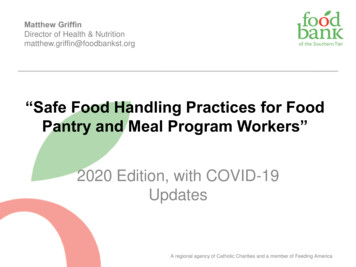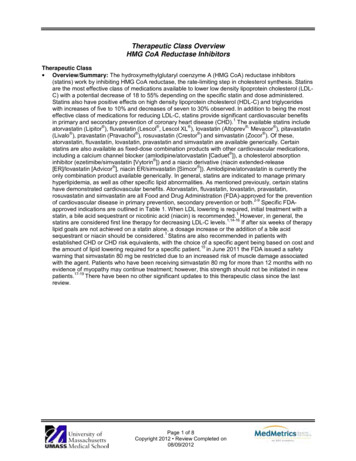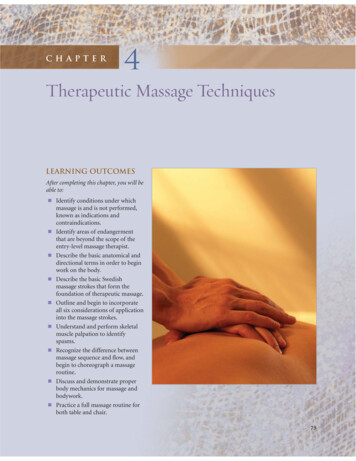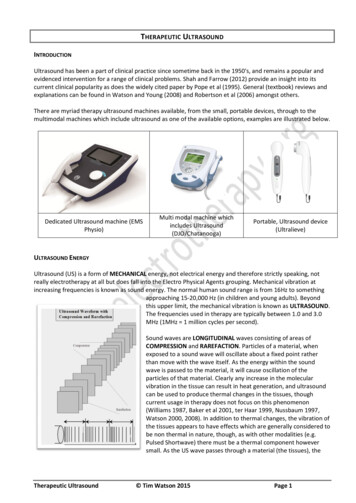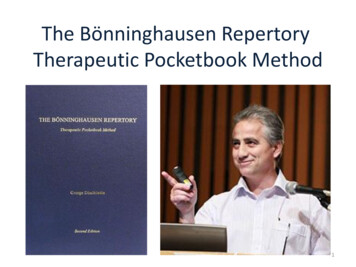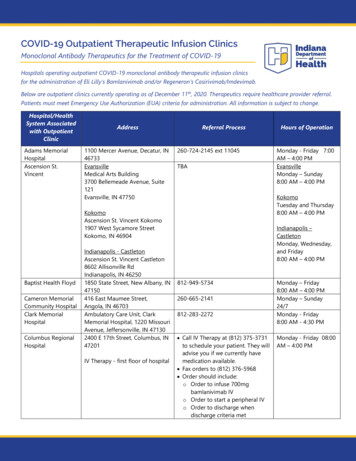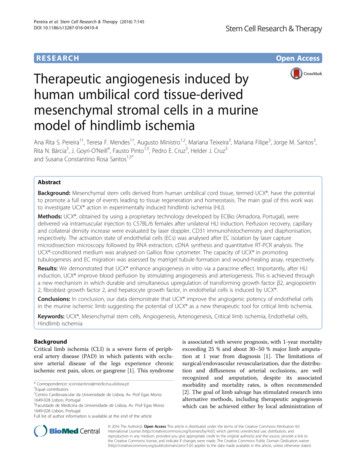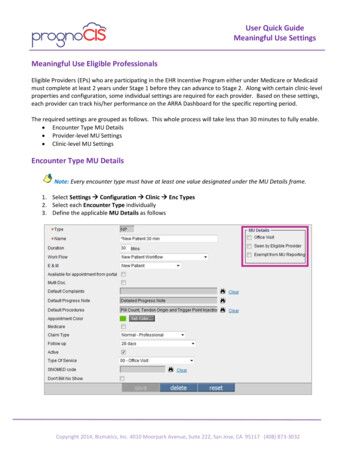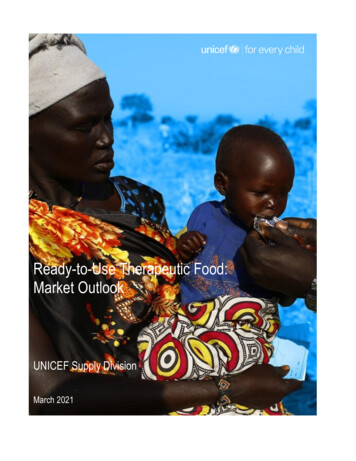
Transcription
Ready-to-Use Therapeutic Food:Market OutlookUNICEF Supply DivisionMarch 20210
Ready-to-Use Therapeutic Food - Current OutlookMarch 2021This update provides information for the period 2017-2023 on ready-to-use therapeutic food supplyand increased supplier diversity. It highlights UNICEF’s procurement approach to meet programmecountry requirements and to introduce alternative formulations. UNICEF procures an estimated 75-80per cent of global funded ready-to-use therapeutic food demand a year, which still only covers 25 percent of the estimated needs of children suffering from severe wasting.1. Summary Most of the ready-to-use therapeutic food (RUTF) is used in emergency response. UNICEF procures an estimated 7580 per cent of the global demand for RUTF, averaging 49,000 metric tons (MT) per year over the last four years, suitableto treat 3.5 million children.1 Despite the high volumes through UNICEF, it still only covers 25 per cent of the globalestimated number of children suffering from severe wasting. RUTF procured by governments, non-governmentalorganizations (NGOs) and other United Nations (UN) agencies cover an additional five to ten per cent. As such,approximately 65-70 per cent of children suffering from severe wasting, globally, do not have access to treatment, andmost live in non-humanitarian contexts, which get less attention.The RUTF supplier base has expanded substantially over the last ten years. UNICEF now procures RUTF from 22different suppliers, of which 18 are located in countries with high levels of malnutrition. The global RUTF productioncapacity currently exceeds the global funded demand and is sufficient to respond to increasing the treatment coverageof children with severe wasting.The interest in non-peanut based RUTF is increasing, particularly from countries where peanuts are not a staple food inlocal diets. To increase the treatment of severely wasted children that have not had access to treatment, UNICEFencourages the validation and access to alternative RUTF formulations.The weighted average price (WAP) for RUTF continues to decrease in response to increased procurement volumes,competition, and supplier diversity. The WAP for RUTF procured for export and use in programme countries decreasedby 28 per cent over twelve years, from USD 57.00 per carton in 2008, to reach USD 41.01 per carton in 2020, making itmore affordable. The WAP for locally produced products decreased by 22 per cent over the same period, even thoughlocally produced RUTF remains higher priced than imported RUTF.UNICEF’s response to RUTF demand during the COVID-19 pandemic has greatly benefitted from having establishedsources of supply locally nearer to the demand. The pandemic has not had a major impact on the RUTF industry’s abilityto respond to the demand, as RUTF manufacturers have often been exempted from closure and lockdowns as they areconsidered an essential business. However, they have still had to deal with delays in the supply of raw materials as wellas logistical constraints. UNICEF anticipates the economic consequences from the pandemic, and the strain placed onroutine health and nutrition services, to result in a sharp increase in malnutrition levels.2, 3UNICEF concluded its last tender in 2018 to cover its April 2019-April 2021 tender period, seeking to maintain a healthysupplier base in programme countries close to beneficiaries, as well as to increase programme coverage by trying tomake RUTF more affordable, and more acceptable, with alternative formulations. Good progress has been made inreaching the target of reducing the global WAP by 10 per cent, compared to the 2018 baseline. However, the disruptionscaused by the pandemic have hampered new product development, trialling, and introduction of innovative RUTFproducts made with alternative ingredients. In addition, they delayed the construction and start-up activities of newmanufacturers in strategic regions. This required UNICEF to extend the tender duration by two years until April 2023.One MT contains 72 cartons of RUTF. One carton (92gr. x 150 sachets) is sufficient to treat one child with 10-15 kg of RUTF over 6-8 weeks.UNICEF and the World Food Programme, Nutrition Crisis Looms as More than 39 billion In-school Meals Missed Since Start of Pandemic, UNICEF,New York, 27 January 2021.3 UNICEF, Impacts of COVID-19 on Childhood Malnutrition and Nutrition Related Mortality UNICEF, New York, July 2020.121
2. Brief BackgroundAn estimated 47 million children under-five suffer from wasting,4 globally,5 of which more than two thirds live in South Asia,and more than a quarter live in Africa.6Most children suffering fromsevere wasting, globally,remain untreated.Source: UNICEF, WHO, WB14.3 million children suffer from its extreme form, severe wasting, and require specialised therapeutic feeding care, and anestimated one million children die annually as a consequence of wasting.7 Severe infectious diseases such as tuberculosis,diarrhoea, and measles, as well as sudden onset food insecurity, are among the leading causes of severe wasting.8 Thedevelopment of RUTF, combined with the adoption of community-based management and treatment of wasting, has greatlyincreased the effectiveness and efficiency of therapeutic feeding care. It also enabled programmes to increase their accessand coverage of populations in need. UNICEF procures RUTF for country programmes and partners in two forms: RUTF paste: A lipid-based energy dense, micronutrient paste, using a mixture of peanuts, sugar, oil, and milk powder,suitable for children between the ages of 6-59 months.9RUTF biscuits: An energy dense, nutrient-fortified wheat and oat bar suitable for older children.UNICEF procures other related nutrition products including therapeutic milk (F-75, F-100),10 multiple micronutrient powder(MNP),11 vitamin A supplementation,12 and a complex of minerals and vitamins (CMV), which are not described in this note.3. InnovationCurrently all RUTF procured by UNICEF is based on peanuts, sugar, milk powder (providing 50 per cent of the proteins), oil,vitamins, and minerals. It complies with the Joint Statement,13 issued in 2007 by the World Health Organization (WHO), theWorld Food Programme (WFP), UNICEF, and the United Nations System Standing Committee on Nutrition (UNSSCN), whichendorsed community-based management of acute malnutrition (CMAM). Since 2015, UNICEF has requested manufacturersto propose products based on using alternative ingredients for review and future consideration, including non-peanut basedingredients or alternatives to milk. Not only can alternative ingredients generate cost savings in producing RUTF, but nonpeanut recipes may also increase acceptability in many countries where peanut-based products are not a staple food and arerelatively foreign compared to other foods. Some alternative RUTFs use different legumes and cereals instead of peanuts(typically, soy, chickpea, flour, lentils, or oats). These formulations are known and referred to under the category of4 Theterm ‘wasting’ in this document incorporates severe acute malnutrition (SAM), which includes severe wasting, also known as marasmus,kwashiorkor, and marasmus kwashiorkor, with and without the presence of oedema; as well as moderate acute malnutrition (MAM).5 UNICEF, World Health Organization, and the World Bank, UNICEF/WHO/The World Bank Group joint child malnutrition estimates: levels and trendsin child malnutrition: key findings of the 2020 edition, WHO, Geneva, 31 March 2020, p. 2.6 Ibid., p. 7.7 UNICEF, The World Health Organization, The World Food Programme, Community-based Management of Severe Acute Malnutrition: A JointStatement by WHO, WFP, the UN System Standing Committee on Nutrition, and UNICEF, WHO, Geneva, May 2007, p. 2.8 Action Against Hunger, Underlying Causes of Malnutrition, Action Against Hunger, Toronto, 2016.9 Lipids are a class of organic compounds, such as fatty acids or derivatives, and include natural oils, that are insoluble in water but soluble in organicsolvents.10 UNICEF, Therapeutic Milk Market and Supply Update, UNICEF, Copenhagen, June 2020.11 UNICEF, Multiple Micronutrient Powder Supply and Market Outlook, UNICEF, Copenhagen, June 2020.12 UNICEF, Vitamin A Supplementation: Market and Supply Update, UNICEF, Copenhagen, June 2018.13 UNICEF, WHO, WFP, Community-based Management of Severe Acute Malnutrition: A Joint Statement by WHO, WFP, the UN System StandingCommittee on Nutrition, and UNICEF.2
“renovation” products, as they represent a step change in the ingredients used in RUTF, and still comply to the Joint Statementcompositional guideline. They have the same nutrient composition, similar texture, and shelf life compared to peanut-basedpaste, and they can be produced using the existing manufacturing facilities and the established equipment and manufacturingprocesses.Out of the selection of alternative RUTF products offered to UNICEF in the 2018 tender, UNICEF prioritized the soy andchickpea variants for acceptability trialling over the next three to four years. These two ingredients were the most commonlyrepresented products offered in the tender and are predicted to deliver cost savings of around 3-5 per cent.Other pipeline products, categorized as “novel” products, are new RUTF formulations that replace milk protein with otherprotein sources to meet protein requirements, and increase iron and vitamin C compared to the standard composition. Somemanufacturers have also formulated products that fall into the “innovation” category, which use alternative sources of proteinto milk in formulations that may be more culturally adapted and increase local acceptance. These include using differentanimal sourced proteins such as fish or egg powder. Both the “novel” and “innovation” product categories require efficacytrials and considerable investment before they are at a stage of being considered for scale-up into CMAM programmes, asthey do not comply with the Joint Statement. The procurement of these alternative formulations will be subject to anassessment of their suitability for the management of severe wasting following an updated guideline from WHO to supporttheir use in programmes.4. Current Market SituationUNICEF is the main procurer of RUTF, procuring up to 75-80 per cent of global demand. The World Food Programme procuresa similar volume of lipid-based nutrition products as UNICEF, but it procures predominantly the supplementary foods in thisproduct group. UNICEF and WFP account for 70-75 per cent of the global procurement of these products.The United States Agency for International Development’s (USAID) Bureau for Humanitarian Assistance (BHA) has beenproviding in-kind contributions of RUTF to UNICEF since 2012. These donations have been supporting the therapeutic feedingneeds of 25 countries in Africa, in addition to Afghanistan, Bangladesh, Haiti, Myanmar, Pakistan, and Yemen. TheUSAID/BHA contribution of RUTF to UNICEF and of lipid-based nutritional supplements (LNS) to WFP accounts for anadditional five to ten percent of the global procurement of lipid-based nutrition products. The remaining global volumes areprocured directly by governments, other UN agencies, such as the UN High Commissioner for Refugees (UNHCR) and WHO,as well as other organizations such as Action Against Hunger (AAH), the International Committee of the Red Cross (ICRC),and Médecins Sans Frontières (MSF). In 2020, the total volume of RUTF and other supplementary lipid-based nutritionproducts procured reached an estimated 140,000 MT. This volume represents approximately 56 per cent of the current totalglobal production capacity of this product group (Figure 1).Figure 1 Estimated Global Lipid-based Production Capacity and Known Utilization 2020Source: UNICEF Supply DivisionUNICEF manages RUTF as a non-stock item that is made to order due to severalfactors, including its short shelf life of 24 months, typically large order sizes, highnumber of orders, product bulkiness, and the cost of holding finished productinventory. Considering the geographical spread of UNICEF’s supplier base, andthat most manufacturers have a buffer production volume in advance of orders,pre-positioning of stocks of RUTF for emergency preparedness is currently onlyhappening in the region of West Africa, funded by the United Kingdom’s ForeignCommonwealth, and Development Office (FCDO)’s PARSNIP and otherdonors.14,15 The combined global production capacity for lipid-based nutritionproducts is estimated to have increased to reach 245,000 MT in 2020, from over208,000 MT in 2017, and which is more than sufficient to meet sudden increaseddemand from emergencies. Procurement volumes have further increased in thefollowing years, as did manufacturing capacity.United Kingdom, Foreign, Commonwealth and Development Office, Progressing Action on Resilient systems for Nutrition through Innovation andPartnership (PARSNIP), FCDO, London, 20 October 2020.15 The FCDO’s Progressing Action on Resilient Systems for Nutrition through Innovation and Partnership (PARSNIP) is a new strategic collaborationbetween UNICEF and the Government of the United Kingdom on improving the prevention, early detection and treatment of child wasting.143
4.1 DemandUNICEF has procured RUTF since 2000. The growing number of pilot-programmes and the subsequent endorsement ofCMAM in 2007 by WHO, WFP, UNICEF, and UNSSCN, resulted in the demand for RUTF through UNICEF to increase to ayearly average of between 30,000-35,000 MT from 2013 to 2016. This volume corresponds to the treatment of approximately2.1 to 2.5 million children in over 60 countries, driven by emergencies and programmatic acceptance (Figure 2).16 In 2017,the demand spiked to reach 52,620 MT due to multiple emergencies occurring in the Horn of Africa, Nigeria, South Sudan,and Yemen, amongst others. The high level of procurement continued through 2020 to reach 46,900 MT, averaging 49,000MT a year over the last four years, suitable to treat 3.5 million children. Nevertheless, the supply through UNICEF still onlycovers approximately 25 per cent of the global estimated 14.3 million severely wasted children.17 RUTF supplies from othersources, notably from AAH, MSF, USAID, and others, correspond to an additional five to ten per cent of the global estimatedneeds. In other words, most children suffering from severe wasting, globally, remain untreated.Figure 2 UNICEF RUTF Procurement, Forecast, and Number of Countries Supplied 2000-2022Source: UNICEF Supply DivisionThe widespread use of RUTF in emergencies makes country forecasts challenging and often inaccurate. In 2013, UNICEFand partners established the Nutrition Dashboard (NutriDash) to help address these challenges.18 NutriDash is a web-baseddatabase with access limited to key partners. It is used to collect and strengthen nutrition programme information, and usedto support programme management, advocacy, and mobilize resources, as well as to improve country demand forecasting.It helps countries to project supply requirements and ensure timely delivery. As wasting is perceived as a humanitarianproblem, it receives 80 per cent of its funding from humanitarian budgets. However, in reality the condition is more prevalentin non-emergency contexts, whereby approximately 65-70 per cent of the children suffering from severe wasting, globally, donot have access to treatment, and live in non-humanitarian, stable development environments, which often get less attention.Over the last few years, there has been a growing interest by donors and other partners to invest in innovative and catalyticsupply financing.19 The aim is to increase domestic resource allocation in the treatment of child wasting and to improvefinancing predictability due to the nature of humanitarian budgets account for 80 per cent of its funding. The Nutrition MatchFund,20 seeks to match domestically mobilized spending on RUTF, and the nutrition window of the Vaccine IndependenceInitiative (VII) addresses temporary cash flow timing issues via pre-financing.One MT contains 72 cartons of RUTF. One carton (92gr. x 150 sachets) is sufficient to treat one child with 10-15 kg of RUTF over 6-8 weeks.UNICEF, WHO, and the World Bank, Levels and Trends in Child Malnutrition.18 UNICEF, NutriDash, UNICEF, New York, 2019.19 UNICEF, Supply Financing, UNICEF, Copenhagen, February 2021.20 UNICEF, New Fund Aims to Unlock 1 Billion for Children’s Nutrition, UNICEF, New York, April 2015.16174
UNICEF expects demand could increase further as a result of higher coverage rates, improved management approaches tosevere wasting, as well as a growing focus on hunger and malnutrition to meet the Sustainable Development Goals (SDGs).The SDGs, adopted by the UN General Assembly in September 2015, seek to end all forms of malnutrition by 2030, includingachieving the World Health Assembly (WHA) targets to bring childhood wasting below five per cent and reducing stunting by40 per cent by 2025. It will require the rapid expansion in both the reach and coverage of targeted feeding programmes,notably CMAM, and the use of RUTF. The World Bank estimates nutrition interventions could save up to 3.7 million child livesand 65 million fewer stunted children, compared to a 2015 baseline, should programmes reach their targets by 2025.214.2 COVID 19 Pandemic and Malnutrition OutlookThe global COVID-19 pandemic resulted in an initial increase in demand as programmes built up buffer stocks in anticipationof production problems and logistical constraints. The RUTF industry has been less affected by lockdowns and border closuresthan other sectors as RUTF and food manufacturers were exempt and considered as essential businesses. UNICEF has alsogreatly benefitted from having established sources of supply locally in programme countries nearer to the demand. UNICEFis also noting that there is growing evidence that the economic consequences of the pandemic, in addition to the reductionsin routine health and nutrition services, are resulting in an increase in malnutrition levels.22, 23Within the context of UNICEF and WFP’s new partnership framework to address wasting in children globally,24 UNICEF andWFP have joined forces to scale up the prevention and treatment of child wasting in response to the anticipated increasedneed of prevention and treatment services due to the consequences of global lockdown restrictions and COVID-19.25The two agencies will be leading the adaptation and scale up nutrition programmes to avoid a major increase in the burdenof child wasting due to the containment measures and the socio-economic impact of the pandemic. Based on respectivemandates, comparative advantages, and operational capacity, UNICEF and WFP will work in coordination with national/subnational governments and nutrition sector/cluster coordination platforms to support the design and scale-up of context-specificsimplified approaches for the early detection and treatment of child wasting.Both agencies have intensified their efforts to strengthen the capacity of mothers and caregivers to detect and monitor theirchildren’s nutritional status using low-literacy/numeracy tools including mid-upper arm circumference (MUAC) tapes, prepositioning (with a minimum buffer stock of two months) of essential commodities for the prevention and treatment of childwasting including RUTF and LNS products at national, community and health facility levels.204.3 Supplier BaseFrom 2000-2007, the RUTF market had a single qualified international supplier producing RUTF for export, from whichUNICEF sole-sourced supply to meet demand. In response to growing country programme demands and programmepreferences for locally produced RUTF for in-country use, and for reasons of economic development and supply chainefficiencies, the sole-source supplier established local franchises in programme countries. This coincided with increaseddemand from a growing number of countries. Local franchises increased local supply availability and supported broadereconomic and development goals by providing employment, the transfer of technical, production, supply chain knowledgeand expertise, in addition to increasing global production capacity. UNICEF also sought to diversify the supply base beyondlocal franchises, and encouraged independent quality suppliers, particularly in programme countries to enter the market. Tomeasure progress, UNICEF adopted a supply outcome target to source 50 per cent of RUTF procurement from supplierslocated in programme countries by 2016.To facilitate these efforts, UNICEF developed manufacturing and product standards as well as a strong quality assurancesystem to help mitigate the risks of microbiological contamination associated with peanut- and milk-based products (i.e.Enterobacteriaceae, Salmonella). UNICEF also strengthened country demand forecasts and used competitive bidding intenders to improve market efficiency and leverage competition. UNICEF apportioned total forecasted quantities amongThe World Bank, Investing in Nutrition, the Foundation for Development, the World Bank, Washington, 2016.UNICEF and the World Food Programme, Nutrition Crisis Looms as More than 39 billion In-school Meals Missed Since Start of Pandemic, UNICEF,New York, 27 January 2021.23 UNICEF, Impacts of COVID-19 on Childhood Malnutrition and Nutrition Related Mortality UNICEF, New York, July 2020.24 UNICEF and the World Food Programme, Addressing Wasting in Children Globally: UNICEF and WFP Partnership Framework, the EmergencyNutrition Network, Kidlington, October 2020.25 UNICEF and the World Food Programme, Supporting Children's Nutrition during the Covid-19 Pandemic, UNICEF, Copenhagen, April 2020.21225
suppliers with production facilities that meet UNICEF’s technical requirements and product specifications, while balancingevaluation criteria between pricing (landed cost), quality, and the capacity to respond to demand to maintain a healthy market.As a result, the number of UNICEF RUTF paste suppliers increased from one supplier in 2007 to reach 21 suppliers as ofMay 2020, of which 18 (86 per cent) are suppliers based in countries with high concentrations of malnutrition. One suppliersupplies RUTF in biscuit form (Table 1).Table 1 UNICEF Supply Arrangements for RUTF in 2019-2021 (2023 for RUTF biscuits)Supplier1Amul Dairy (Kaira), India2Compact, India3DABS Nigeria4Diva Nutritional Products, South Africa5Edesia, USA6GC Rieber Compact, Norway7GC Rieber Compact, South Africa8Hexagon, India9Hilina, Ethiopia10 InnoFaso, Burkina Faso11 Insta Products, Kenya12 Ismail Industries, Pakistan13 Mana Nutritive Aid, USA14 Meds for Kids, Haiti15 Nuflower Foods and Nutrition, India16 Nutriset, France17 NutriVita Foods, India18 Project Peanut Butter, Malawi19 Samil Industry, Sudan20 Société de Transformation Alimentaire, Niger21 Société JB, Madagascar22 Soma Nutrition, IndiaSource: UNICEF Supply DivisionType of 21Apr-21Apr-21Apr-21Apr-21Apr-21ProductRUTF PasteRUTF PasteRUTF PasteRUTF PasteRUTF PasteRUTF BiscuitsRUTF PasteRUTF PasteRUTF PasteRUTF PasteRUTF PasteRUTF PasteRUTF PasteRUTF PasteRUTF PasteRUTF PasteRUTF PasteRUTF PasteRUTF PasteRUTF PasteRUTF PasteRUTF PasteUNICEF will continue to be the main buyer of RUTF for the foreseeable future, as it is an essential and core product in thetreatment of wasting at community level. However, the price of RUTF is limiting the generation of additional demand eventhough the market has a sufficient number of suppliers. UNICEF’s procurement strategy is to meet programme needs withquality-assured products acceptable to beneficiaries, at the lowest acceptable price, while sustaining a healthy, diverse, andgeographically well-spread, responsive, good manufacturing practice (GMP)-approved production capacity. UNICEF’s 2018tender, which resulted in contracts for the period April 2019-April 2021, sought to:UNICEF is making good progress towards reaching its target of reducing the global WAP by 10 per cent compared to its 2018baseline, even though the disruptions caused by the pandemic have hampered the trials and introduction of innovative RUTF6
with alternative ingredients The pandemic also delayed the construction and start-up activities of new manufacturers instrategic regions. Based on the above, UNICEF decided to extend its tender duration by two years until April 2023.4.4 Sustainable ProcurementSustainable procurement (SP) is an approach to procurement that incorporates the three sustainability pillars of social,economic, and environmental impact considerations. It goes beyond the more familiar “green” public procurement, to ensurethat all products and services procured support local economic and social development, with the least environmental impact,and the best value for money (VfM).Sustainable Procurement ConsiderationsIn implementing SP, UNICEF will seek to include green manufacturing quality management system and socialconsiderations, SP criteria in tender commercial evaluations, and specific supply targets to develop local industrycapacity in programme countries.In applying SP, many UNICEF procurement decisions will face trade-offs between SP’s three (economic, social, andenvironmental) pillars, and present key operational challenges, especially between environmental and socialconsiderations, with the latter often being more difficult to quantify. The absence of evidence to make any informedtrade-off decisions will be part of the challenge. The other challenge will be the difficulty to make value judgments toprioritize one pillar over the other. However, solutions will be situation specific and priorities based on readiness, marketinfluence, and targeted objectives.Some SP elements, notably under the social pillar, may put some pressure on short-term costs that generate longerterm savings, such as investments in fairer employment working conditions, or health and safety, which would be offsetby increased motivation, productivity, and reductions in work-related injury and absenteeism. To achieve higher tangibleeconomic benefits and VfM, UNICEF and industry will strive to manage procurement decisions based on longer-termperspectives, considering the advantages of environmentally, socially sound products and services, and betterperforming staff, bring in the long-term.In February 2018, UNICEF released its Procedure on SP (SUPPLY/PROCEDURE/2018/001). The procedure constitutesUNICEF’s policy on SP and is applicable across all UNICEF offices engaged in supply planning and procurement, whereverfeasible and applicable, whether for goods or services, or for programmes or office assets, read more here.26Through its tender, UNICEF documents the RUTF industry’s current sustainability practices and collects information it canuse to establish a baseline with a focus on the three pillars. To support the many initiatives already planned and implementedby RUTF manufacturers, UNICEF will monitor progress on sustainability with due consideration for the health of the marketand the finished product’s affordability.Figure 3 UNICEF RUTF (Paste) Procurement by Production Region of Origin 2007-2020Source: UNICEF Supply Division26UNICEF, Sustainable Procurement, UNICEF, Copenhagen, September 2018.7
UNICEF’s share of RUTF procurement from suppliers based in programme countries has steadily increased. Apart from adecrease from 50 per cent in 2012 to 25 per cent in 2013 on account of updated quality requirements for finished products,procurement from suppliers based in programme countries increased to 37 per cent in 2015 (Figure 2, page 4). UNICEFexceeded its target to source at least 50 per cent of RUTF from suppliers located in programme countries at the end of 2016by reaching 56 per cent and increasing this level to reach 71 per cent in 2020 (Figure 3, previous page).The key advantages programmes can have from increased local production capacity include improved local availability andacceptability, government endorsement, and it can contribute to supply chain cost efficiency, as well as reduced delivery leadtimes. UNICEF compared two of its recent emergency response peak periods of demand in the Horn of Africa, covering theperiod of April to September in 2011, with the same period in 2017 (Figure 4).27In 2011, UNICEF had to source all its RUTF supply, 8,335 MT (9,167 MT gross) off continent, spending USD 6.5 million onfreight including USD 4.5 million on international air freight alone. By contrast in 2017 during the peak of the emergencyresponse, UNICEF was able to source 48 per cent of its 6,372 MT (7,009 MT gross) RUTF supply from manufacturers in theHorn of Africa, eliminating the need for the use of air freight. As it sourced a greater share of its supply nearer the areas ofneed in 2017, it contributed to cost-reduction of 21 per cent in USD per MT*, reducing the average cost per MT by USD830.30, from USD 4,003 in 2011, to USD 3,173 in 2017, due to reductions in net product prices, and as supply relied oncheaper overland and sea freight costs, rather than far more expensive international air freight as compared to 2011. Thereduction in average freight cost per MT was USD 556.00, which is a 79 per cent reduction from USD 710.00 in 2011, to USD154.00 in 2017, and which in turn, contributed to an 89 per cent reduction in carbon emissions (Figure 4).Figure 4 Influencing Markets Near Programme Countries in EmergenciesSource: UNICEF
ingredients or alternatives to milk. Not only can alternative ingredients generate cost savings in producing RUTF, but non-peanut recipes may also increase acceptability in many countries where peanut-based
